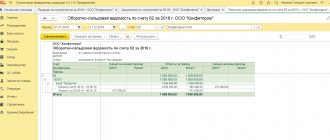Types of accounts receivable
There are several types of accounts receivable. We are talking about normal and expired.
- In the first case, we are talking about debt for certain goods, which in fact already belong to the buyer, but the payment period has not yet arrived.
- Overdue accounts receivable are debts for goods for which payment has not been received within the time period specified by both parties. In turn, this type of debt may be doubtful or hopeless. In the latter case, the problem is resolved with the participation of collection agencies.
Regardless of the maturity date of receivables, they relate exclusively to the current assets of the company. Accordingly, this amount is managed at enterprises within clearly established limits. This function is often assigned to a financial manager, general or commercial director. In addition, responsibilities may be divided between the legal department and managers.
Differences between accounts payable and receivable
Beginning entrepreneurs can sometimes think that it is good to have accounts receivable and bad to have accounts payable. In the common understanding, a debtor is everything that is owed to you, a creditor is everything that you owe.
The absence of debts in favor of individual entrepreneurs on the part of counterparties indicates a cautious strategy. Because of fear of taking risks, the entrepreneur works only on prepayment or settlements on the day of delivery. But such an approach is impossible in the long term. Moreover, it deprives the business of part of the profit that conscientious payers can bring.
Accounts payable is a more indicative parameter. Many companies can manage almost completely without it. But with the expansion of client relationships, contractual relationships with partial prepayments still arise, or the client borrows from other lenders.
Even the formed wage fund, the amount for paying dividends to shareholders or the amount of accrued taxes are classified as accounts payable. Therefore, it is more correct to evaluate not the presence of receivables and creditors as such in the balance sheet of the enterprise, but to pay attention to their ratio.
If you do not use accounting formulas, then you can briefly formulate the following theses:
- When the creditor is higher than the debtor, the company does not have enough of its own finances. There are some apparent stability issues. But at the same time, other company resources are also taken into account.
- If the debtor is several times higher than the creditor, then the company is economically healthy, reliable and solvent.
It is important to remember that a significant bias in either direction is unfavorable for a stable business.
Long-term and short-term accounts receivable
The division of receivables into long-term and short-term is determined by the timing of debt repayment by accountable persons, borrowers, customers, and buyers.
Long-term accounts receivable are those in which debts are repaid after a period of 12 months after the conclusion of the contract. This is a non-current asset of the enterprise. This debt is assessed and displayed on the balance sheet at its current value, taking into account accrued interest.
There are several types of long-term receivables:
- for property transferred under financial lease, for example, equipment, buildings, housing;
- received long-term bills, which are a tool for long-term attraction of financial resources to finance the acquisition of specific assets, the implementation of long-term projects related to the implementation of real investments, etc.
That is, this is a large loan of funds from an organization that is subject to long-term repayment.
Short-term receivables are debts that are characterized by a short time to repay the debt - up to a year after the reporting date. It includes the debt of buyers and customers for goods and services - it is possible to secure them with bills of exchange.
This type includes settlements with the budget, repayment of debts on advances paid, accrual of income for the provision of funds for use, internal settlements, etc.
Short-term receivables are treated as payment subject to adjustment of the allowance for doubtful debts or overdue and bad debts. It dominates the total amount of debt because deferment of payment on debt for a period of more than a year is very rare.
Long-term accounts receivable - line on the balance sheet
Clause 73 “Regulations on accounting and financial reporting in the Russian Federation” (Order of the Ministry of Finance of the Russian Federation dated July 29, 1998 No. 34n) requires that the company’s receivables be reflected in the statements in the amounts following from its accounting records, which are considered correct by default.
The forms of financial statements of organizations are approved by the order of the same name of the Ministry of Finance of the Russian Federation dated July 2, 2010 No. 66n. In the organization's balance sheet, line 1230 is allocated to reflect receivables. This line reflects all receivables, which are listed at the end of the reporting period in accounts 46, 60, 62, 68, 69, 70, 71, 73, 75 and 76, minus the credit balance on account 63. But there are nuances:
- organizations on OSN that have prepayments to suppliers or contractors as receivables for future deliveries of goods or performance of work, including VAT, show these amounts excluding VAT in line 1230. These are the recommendations of the Ministry of Finance (letter dated 01/09/2013 No. 07-02-18/01);
- line 1230 does not show prepayments to suppliers or contractors caused by the acquisition or construction of fixed assets - it should be shown in the section intended to reflect non-current assets.
This means that line 1230 of the balance sheet shows accounts receivable without breaking it down into current and long-term. But clause 19 of PBU 4/99 “Accounting statements of an organization” (Order of the Ministry of Finance of the Russian Federation dated July 6, 1999 No. 43n) requires the separation of information about the short- and long-term assets of the organization. To fulfill this requirement, it is necessary to create additional lines to line 1230 to separately reflect debt for which repayment is expected within 12 months from the reporting date, and long-term debt.
An example of filling out line 1230 “Accounts receivable” of the balance sheet from ConsultantPlus An organization created in July 2021, as of December 31, 2021, has accounts receivable from: suppliers and contractors for advances issued by the organization with a repayment period of less than 12 months after the reporting date - in in the amount of 4,800 thousand rubles, including VAT 800 thousand rubles; See the full example in K+. Trial access to the system is free.
Order No. 66n in Appendix No. 3 contains examples of formatting explanations for the balance sheet. Section 5 of this application contains tables 5.1 and 5.2, intended to decipher information about existing receivables. Table 5.1, called “Availability and movement of receivables,” describes short-term debt separately and long-term debt separately. Table 5.2 reflects information about existing overdue receivables.
You can familiarize yourself with all the balance sheet items included in the asset or liability, with a decoding of the balance sheet line codes and indicators of the items in the material “Deciphering the balance sheet lines (1230, etc.).”
An increase in accounts receivable - what does this mean, consequences
The dynamic growth of accounts receivable leads the company to certain financial difficulties. The desire to increase profits by any means possible without taking into account the possible consequences can lead to disastrous results.
For the banking system, an increase in accounts receivable means “pulling out” working capital from circulation and providing it to the borrower in order to receive additional income by returning the loan taken by the client with interest for using the loan. Non-repayment of a loan is a loss of the bank’s own money, and if the number of hopeless defaulters grows and the corresponding work to repay debts is not carried out, then the bank faces losses leading to inevitable bankruptcy.
Also for a trading company, a long-term debt to defer payments for services provided or products supplied can lead to unpleasant consequences in terms of the financial state of affairs and lead to a court settlement.
The solvency of an organization directly depends on the successful management of current assets, and preventing the growth of accounts receivable will prevent a shortage of working capital. If there is inadequate control over payment and settlement discipline and loans are provided without sufficient consideration of the borrower’s solvency, analysis of his reliability in repaying the loan, or market monitoring, then in this case the organization obviously dooms itself to a decrease in the liquidity of its own assets and a decrease in funds in its accounts.
The main goal of the company's management is to keep debt within an acceptable level, which depends on the size of the enterprise, on production volumes, on its territorial affiliation and on many other factors.
Short-term debt
Short-term debt is a type of debt that involves its repayment over a period of no more than one year. Payments on such debt, in most cases, are made by using funds from circulation. Short-term debt of the enterprise, debt on interest and debt on dividends, bills that were issued, as well as arrears of wages and advance payments - all these types of debt are short-term obligations.
Types of short-term debt
1) Short-term accounts payable – funds that are used to pay creditors for goods purchased and services received. In the balance sheet, such debt is one amount made up of separately calculated balances.
2) A bill of exchange is an unconditional obligation to pay a clearly defined amount of funds in the future, at a certain time. Such an obligation is made in writing. The reasons for issuing bills can be: obtaining loans from a bank, issuing bills to secure short-term debt, or acquiring assets.
3) Credit debt and short-term loan debt is the amount of funds borrowed that were not covered at the end of the reporting period, which had to be repaid according to agreements no later than the expiration of 12 months following the reporting date.
4) Interest-bearing debt - the accrued amount of interest, for example, on securities, credit loans for short periods. At the time the company's balance sheet was compiled, such interest had accrued but had not been paid.
5) Dividend debt is the dividend debt payable to shareholders. Such dividends are a distribution of profits. At the time of preparing the balance sheet, such declared dividends are nothing but the short-term debt of the enterprise, which has not yet been paid.
6) Wages arrears - wages not paid to the employees of the enterprise, but due to them as of the date of publication of the balance sheet. That is, the deadline for the payment of wages has not yet arrived at the time of drawing up the balance sheet documentation.
7) Other short-term debt is certain amounts that need to be paid for goods or services not directly related to the company’s activities. Based on IAS standards, such debt should include debt for social insurance and security, as well as for company property insurance.
 Received advance payments - are formed upon receipt of payment for the supply of material resources or for the performance of any work. Such advances are an obligation to return a received asset, an obligation to provide a specific service, or a promise to fulfill other contractual obligations (mainly during the period that follows the reporting period).
Received advance payments - are formed upon receipt of payment for the supply of material resources or for the performance of any work. Such advances are an obligation to return a received asset, an obligation to provide a specific service, or a promise to fulfill other contractual obligations (mainly during the period that follows the reporting period).
Types of receivables
In accounting, types of receivables are determined by the method of occurrence; return period and form of occurrence.
According to the form of occurrence they distinguish:
- Trade receivable - appears in the process of production activities. This could be deferred payments provided to customers or prepayments made for material and technical assets or services;
- Non-trading - not directly related to the production and sale of products: advances on wages to employees, excessively transferred money when fulfilling obligations to all types of budget (taxes, funds), dividends paid before the end of the year, etc.
By return period:
- Long-term , more than a year, receivables;
- Short-term - repayment within 12 months.
The most important types of receivables that significantly affect the results of the lender’s work:
- Normal (in accountant slang you can also find: standard and ordinary). Arises as a result of meaningful actions of employees of a company (enterprise) acting within the framework of concluded contracts when selling goods or purchasing materials or raw materials, overpayments to the budget, issuing cash to employees;
- Overdue (also called unjustified) - the deadline for payment or delivery of products in accordance with contracts has arrived, but there is no receipt of money in the current account (at the enterprise's cash desk) or delivery of paid products.
In turn, expired is divided into a number of subtypes:
- Doubtful. The debtor has serious financial problems, and therefore there are risks of non-repayment of the debt;
- Unclaimed. Debts that the company itself forgot about and did not demand repayment of the debt in a timely manner. Only the employees of the organization are to blame. The debtor will always put off repaying the debt until the last minute. They reminded me and I paid immediately;
- The moratorium is the most offensive. Occurs in the event of revocation of the license of the bank in which the current account is opened;
- Hopeless - the probability of return does not exceed 0.0%.
Doubtful and bad receivables
doubtful until the payment period has expired. If there is no specific date in the agreement with the counterparty, then it is determined subjectively based on the nature and content of similar transactions. In addition, a debt can be recognized as doubtful not only based on the date, but when information about the financial difficulties of the counterparty was published in the media or other sources. As soon as suspicions arise that a receivable may become dubious, accounting begins to form reserves for it.
hopeless when the company has no chance of repaying it. This happens in two cases:
- The statute of limitations has expired . The period is calculated from the date when the delay began from the date of fulfillment of obligations by the debtor. The maximum period is 3 years.
- The obligation cannot be fulfilled . For example, a company was declared bankrupt and excluded from the register of legal entities. But if the debtor is an individual entrepreneur, then even after deregistration he continues to be liable for debts with his property. The individual entrepreneur's debt will be considered uncollectible if he begins personal bankruptcy proceedings and the bailiffs will have nothing to collect debts from.
Very rarely does a receivable immediately become uncollectible. Usually the process starts with doubt. The company decides how to form a reserve for doubtful debts after conducting an inventory.
Line 1230 of the balance sheet “Accounts receivable”
January 10, 2021 9276
Accounts receivable (line 1230)
This line of the balance sheet reflects the accounts receivable to the company, which was formed as of December 31, 2015. In this case, line 1230 includes debts whose repayment period is equal to or less than 12 months. If the repayment period of the debt exceeds 12 months, then its amount is included in non-current assets in line 1190 “Other non-current assets”. The amounts of advances transferred to contractors for future work related to capital construction are also indicated here.
Lines 1230 and 1190 indicate the debit balance of accounts for accounting for settlements:
60 “Settlements with suppliers and contractors” in terms of advances transferred on account of the upcoming supply of material assets, performance of work, provision of goods, works or services in terms of the cost of goods, work or services shipped but not paid for by buyers and customers;
68 “Calculations for taxes and fees” regarding taxes excessively transferred to the budget or collected by the tax authority;
69 “Calculations for social insurance and security” in terms of contributions to compulsory social insurance, excessively transferred or collected to extra-budgetary funds;
70 “Settlements with personnel for wages” regarding overpaid wages;
71 “Settlements with accountable persons” in terms of accountable amounts issued to employees of the company and unspent or unreturned at the end of the reporting period;
73 “Settlements with personnel for other transactions” in terms of the amount of loans provided to the company’s employees and their debt for compensation for material damage;
75 “Settlements with founders” in terms of debt of founders for contributions to the authorized capital in terms of sanctions accrued and recognized by debtors for violation of the terms of business contracts, dividends due from other organizations, accrued income from joint activities, the amount of issued interest-free loans, third-party debts persons for other transactions.
The company can provide details of the amounts of receivables by type and composition (for example, debt from buyers or customers; budget or extra-budgetary funds; personnel of the organization; shareholders or participants, etc.) in Section 5 of the Explanations to the Balance Sheet and Statement of Financial Results. Table 5.1 is intended for this purpose.
For doubtful accounts receivable related to payments for goods, works or services supplied, which are not repaid within the time limits established by the contract and are not provided with appropriate guarantees, the company is obliged to create a special reserve. This is provided for in paragraph 70 of the Regulations on Accounting and Financial Reporting. Whether the creation of such a reserve is provided for by the company’s accounting policy or not is not important. It is reflected in the credit of account 63 “Provisions for doubtful debts” in correspondence with account 91 “Other income and expenses” subaccount 2 “Other expenses”. If such a reserve is created, then the balance sheet indicates the accounts receivable minus the amount of the reserve (that is, the debit balance on accounts 62 and 76 minus the credit balance on account 63).
Please note: in the balance sheet, accounts receivable and accounts payable are indicated in detail. The receivable is in the asset, and the creditor is in the liability. That is, these debts do not balance. Even if there were both debit and credit balances for the analytical accounts of the same account.
The company received materials worth RUB 1,180,000 from its counterparty. (including VAT - 180,000 rubles). At the same time, she transferred an advance to the same supplier for the upcoming delivery of goods in the amount of 2,000,000 rubles. Goods are not subject to VAT.
These transactions were reflected in the entries:
DEBIT 19 CREDIT 60 subaccount “Settlements with suppliers”
– 180,000 rub. — “input” VAT on capitalized materials is taken into account;
DEBIT 10 CREDIT 60 subaccount “Settlements with suppliers”
– 1,000,000 (1,180,000 – 180,000) — materials were capitalized;
DEBIT 68 CREDIT 19
– 180,000 rub. — accepted for deduction of VAT on materials;
DEBIT 60 subaccount “Settlements for advances issued” CREDIT 51
– 2,000,000 rub. — funds are transferred as advance payment for goods.
In this situation, accounts receivable in the amount of 2,000,000 rubles. indicated on line 1230 of the balance sheet. At the same time, line 1520 reflects the amount of accounts payable in the amount of RUB 1,180,000. (1,000,000 + 180,000).
Formation of accounts receivable.
The procedure for generating receivables depends on the terms of the transaction within which they arose. In general, its amount is equal to the contract price of the goods, works or services sold. Moreover, in a number of situations it is formed in a special order. Thus, the amount of debt can be increased or decreased if the company provides customers with a commercial loan, if the debt is expressed in conventional monetary units or foreign currency, if it arose as a result of the transfer of an advance, etc. In addition, a special procedure has been established for debts on commodity exchange transactions.






